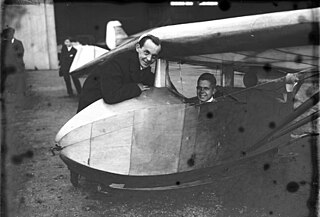
Alexander Martin Lippisch was a German aeronautical engineer, a pioneer of aerodynamics who made important contributions to the understanding of tailless aircraft, delta wings and the ground effect, and also worked in the U.S. His most famous designs are the Messerschmitt Me 163 rocket-powered interceptor and the Dornier Aerodyne.

The DFS 194 was a rocket-powered aircraft designed by Alexander Lippisch at the Deutsche Forschungsanstalt für Segelflug.

Alexander Lippisch's Delta IV was a continuation of his work on delta wing designs pioneered in his Delta I, Delta II and Delta III aircraft.

The DFS 40 was a tail-less research aircraft designed by Alexander Lippisch in 1937 as a follow-on to his Delta IV aircraft. In construction, the DFS was closer to a flying wing than its predecessor, and was built as an alternative to that aircraft.

The Dornier Do 12 Libelle III was the third of a line of small German flying boats of the 1930s. It started with the Dornier A Libelle I and the Dornier A Libelle II, though the Do 12 was not a continuation, but an entirely new aircraft.
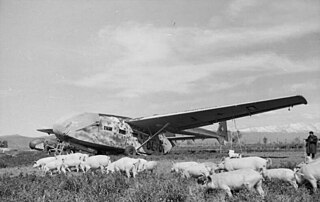
The Gotha Go 242 was a transport glider used by the Luftwaffe during World War II. It was an upgrade over the DFS 230 in both cargo/troop capacity and flight characteristics. Though it saw limited action, it appeared in multiple variants.
The Argus As 292 was originally developed in 1939 as a small, remote-controlled unmanned anti-aircraft target drone. A short-range reconnaissance version was also developed. The success of the project led to the Argus Fernfeuer UAV proposal.
The Messerschmitt Me 265 was a design project for a Zerstörer, produced by leading German aircraft manufacturer Messerschmitt in World War II.
The Klemm Kl 151 was a German prototype light passenger aircraft designed by Dr. Hanns Klemm and chief engineer Carl Bucher during World War II. Only one model was built.
The Focke-Wulf Fw 47 Höhengeier, known internally to Focke-Wulf as the A 47, was a meteorological aircraft developed in Germany in 1931. It was a parasol-wing monoplane of largely conventional design, unusual only in the expansiveness of its wing area. Tested first by the Reichsverband der Deutschen Luftfahrtindustrie, and then the weather station at Hamburg, the type was ordered into production to equip ten major weather stations around Germany.

The Ago Ao 192 Kurier was a small German twin-engined aircraft designed and built by AGO Flugzeugwerke in the 1930s. A small production run of six aircraft followed three prototypes, these being used as transports.
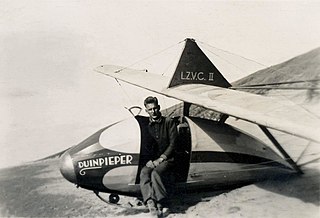
The Zögling is a German high-wing, cable-braced, single seat primary glider that was designed by Alexander Lippisch in 1926 and produced with many variations by a variety of manufacturers.

The Schneider DFS 108-14 SG-38 Schulgleiter is a German high-wing, cable-braced, single-seat primary glider that was designed by Schneider, Rehberg and Hofmann at Edmund Schneider's factory at Grunau in 1938, hence the designation. It was produced by several builders, including Deutsche Forschungsanstalt für Segelflug (DFS).
The Albatros L 103 / Albatros Al 103 was a German experimental aircraft of the 1930s. It was a parasol-wing landplane of conventional configuration, seating the pilot and flight test observer in separate, open cockpits. The Al 103 was used to test variations in sweepback, dihedral and tailplane area.
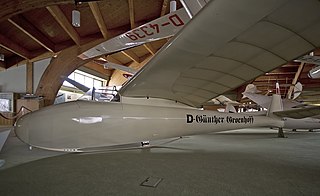
The Schleicher Rhönadler, DFS Rhönadler or Jacobs Rhönadler is a high performance, single seat competition sailplane built in Germany in the 1930s. More than 65 were built.

The RFB X-113 Aerofoil Boat was an experimental ground effect vehicle intended to work over water. It was one of three such aircraft designed by Alexander Lippisch in the 1960s and early 1970s. The X-113 first flew in 1970; only one was built.
The Collins X-112 was an experimental two seat ground effect vehicle, designed by Alexander Lippisch in the United States in the early 1960s to test his thick reverse delta wing concept.
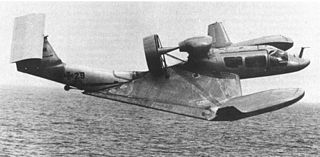
The RFB X-114 was a ground-effect craft, designed chiefly to operate over water but capable of flight at higher altitudes where required, carrying five or six passengers or freight along coasts and capable of surveillance duties. One was evaluated by the German military in the late 1970s, but no orders followed.

The Messerschmitt Me 334 was a proposed German piston-engined fighter, designed by Alexander Lippisch. No examples were built.
The RRG Delta I was a German experimental tailless aircraft flown in the early 1930s first as a glider and then powered. It was one of the first delta wing aircraft.













